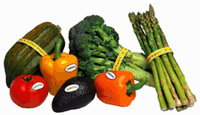
Everything You Need to Know About Organic Foods
What is organic food?
Organic refers to an "earth friendly" and health-supportive method of farming and processing foods. Weeds and pests are controlled using environmentally sound practices that sustain our personal health and the health of our planet. The term "organic" applies to both animal and plant foods.
Organic farmers do not use chemicals (pesticides, fungicides or fertilizers) in an environmentally harmful manner. They utilize a blend of old and new technologies and scientific research to balance the earth's natural ecosystem. Examples of organic farming methods include:
- Rotating crops between fields. This helps keep pests from building up and improves soil fertility.
- Planting select bushes and flowers to attract beneficial insects which ward off unwanted pests.
What You Should Know About Organic Foods
 Just what does it mean when a food is labeled organic? The U.S. Department of Agriculture finally issued a new national seal designed to bring clarity and assurance to consumers that foods bearing the seal are certified organic following USDA standards which were 10 years in the making.
Just what does it mean when a food is labeled organic? The U.S. Department of Agriculture finally issued a new national seal designed to bring clarity and assurance to consumers that foods bearing the seal are certified organic following USDA standards which were 10 years in the making.  Beginning Oct. 21, only foods certified as at least 95 percent organic - that is, produced without most pesticides, toxic fertilizers, growth hormones and antibiotics - will be allowed to carry the official "USDA organic" seal.
Beginning Oct. 21, only foods certified as at least 95 percent organic - that is, produced without most pesticides, toxic fertilizers, growth hormones and antibiotics - will be allowed to carry the official "USDA organic" seal.
One caveat: The new rules apply only to food produced on or after Oct. 21, so it may be several months before the seal becomes commonplace in grocery aisles, particularly on packaged foods where the turnover is slower.
The new USDA national standards replace what had been a mishmash of certification systems run by individual states and private groups. The USDA seal will ensure consumers are actually purchasing a product that is truly organic rather than a creatively worded package that advertises itself as organic when only a few ingredients actually are.
Under the new rules, foods will be labeled as belonging to one of four categories:
- Food that is 100 percent organic may carry the new "USDA organic" label and say "100% organic."
- Food that is at least 95 percent organic may carry the new seal.
- Food that is at least 70 percent organic will list the organic ingredients on the front of the package.
- If a product is less than 70 percent organic, the organic ingredients may be listed on the side of the package but cannot say "organic" on the front.
The national organic program rules prohibit the use of conventional pesticides, petroleum- or sewage-sludge-based fertilizers, bioengineering or ionizing radiation and synthetic substances. Foods certified as organic must be produced using growing methods that minimize soil erosion and that maintain or enhance the fertility of the soil. Organic farms need to prove that these materials have not been used for at least three years. Organic meat, poultry, eggs and dairy products come from animals that are given no antibiotics or growth hormones, must be fed organic feed and have access to the outdoors. Before a product can be labeled "organic," an inspector visits the farm where the food is produced to make sure the farm meets USDA standards.
Look for the word "organic" and a small sticker version of the USDA organic seal on vegetables or pieces of fruit or on the sign above the organic produce display. The word "organic" and the seal may also appear on packages of meat, cartons of milk or eggs, cheese and other single-ingredient foods. Use of the seal is voluntary.
The federal government's stamp of approval is an important step toward mainstream acceptance for the rapidly growing industry. Organic food sales in the U.S. are increasing by about 20 percent a year and are expected to surpass $11 billion in 2002 and $20 billion in 2005.
The new USDA's national criteria for labeling are aimed at enabling consumers to make an educated choice among the foods they purchase and also include the safeguard of fines for misrepresentation. New federal laws for organic certification assess penalties of up to $10,000 for each violation of selling or labeling products "organic" when they are not or when organic food is contaminated with non-organic compounds. This means that the organic grapes can.t be contaminated by the non-organic apples. Separate tubs and wash water are used to trim and clean produce and if there is an organic display in a place where non-organics have been, it is required that the nonskid mats be replaced and the area cleaned with a mild, bleach solution.





